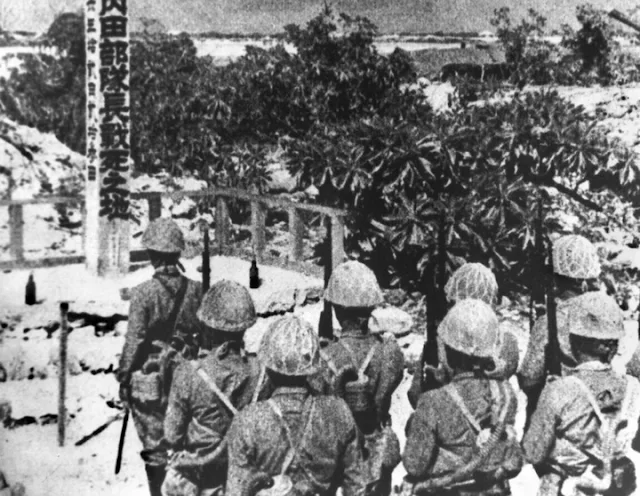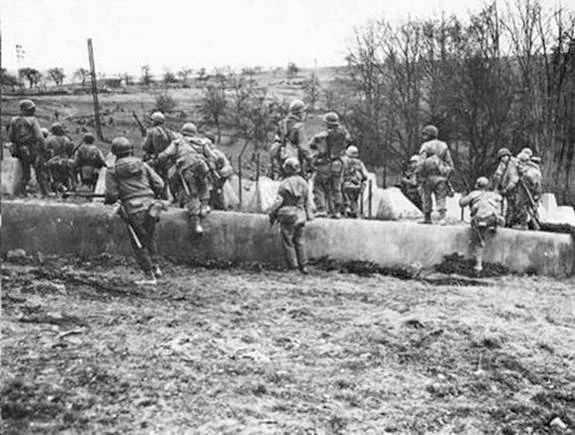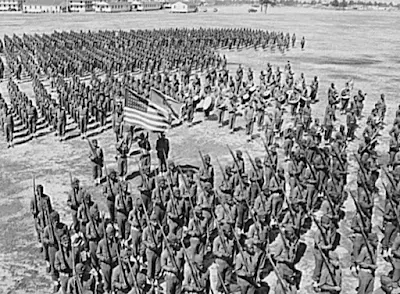 |
| The man in charge of D-Day, General Dwight D Eisenhower and his senior commanders at Supreme Allied Headquarters in London, February 1944. |
 |
| Omaha Beach secured shortly after D-Day, dozens of ships unload hundreds of vehicles and thousands of troops, June 1944. |
 |
| View of part of a harbor on the French Moroccan coast through a hole blasted in the wall of a building by attacking Allied forces during the invasion. |
 |
| General Douglas MacArthur confers with President Manuel Quezon of the Philippines on Corregidor as the campaign was coming to a close. |
 |
| Allied soldiers wade out to rescue vessels, Dunkirk, May 1940. |
 |
| General Dwight D. Eisenhower and Secretary of the Navy James Forrestal, following a conference at the Allied commander's advance headquarters in Normandy, August 1944. |
 |
| Canadian postage stamp issued in 1992 commemorating the 50th anniversary of the construction of the Alaskan Highway. |
 |
| German caseless 7.92-mm cartridge. |
 |
| Japanese propaganda leaflet dropped on Bataan. |
 |
| Japanese propaganda leaflet dropped on Corregidor. |
 |
| Propaganda leaflet dropped by the Japanese on Bataan in early 1942. |
 |
| Soviet propaganda poster, 1941: “The Motherland Calls!” |
 |
| Prisoners at Dachau concentration camp cheer as the US 42nd Division pass by after they liberated the camp, 3 May 1945. |
 |
| President Roosevelt, Prime Minister Winston Churchill, Admiral Ernest King, and General George C. Marshall, meet at the Trident Conference in Washington D.C., May 1943. |
 |
| Gen. Carl Spaatz, Gen. George Patton, Gen. James Doolittle, Lt. Gen. Hoyt Vandenberg, and Maj. Gen. O. P. Weyland at a meeting in Europe. |
 |
| Three U.S. soldiers look at bodies stuffed into an oven in a crematorium in April of 1945. Dachau concentration camp. |
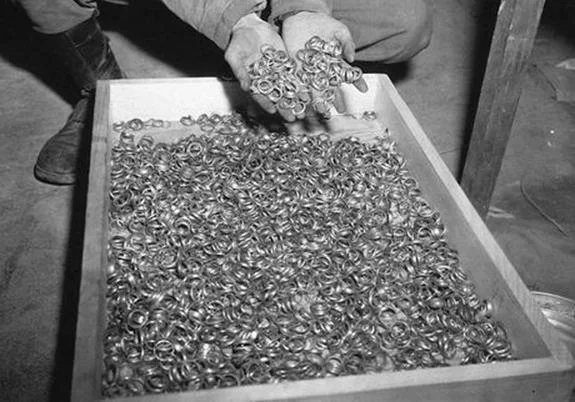 |
| A U.S. soldier inspects thousands of gold wedding bands taken from Jews by the Germans and stashed in the Heilbronn Salt Mines, on May 3, 1945 in Germany. |
 |
| Generals Eisenhower, Bradley, and Patton view a pyre where corpses were burned at the Ohrdruf concentration camp, April 12, 1945. |
 |
| Lving skeletons at the Ebensee concentration camp, a sub-camp of Mauthausen. |
 |
| Document, "Instructions To All Persons of Japanese Ancestry," Civilian Exclusion Order posted by the Western Defense Command, 1942. (Pages 1 and 4) |
 |
| Document, "Instructions To All Persons of Japanese Ancestry," Civilian Exclusion Order posted by the Western Defense Command, 1942. (Pages 2 and 3) |
Following the attack on Pearl Harbor by Japan on December 7, 1941, President Franklin Roosevelt issued Executive Order 9066 on February 19, 1942, a presidential executive order that authorized the deportation of Japanese-Americans and Italian-Americans to prison camps. Shortly following this, orders were issued to Japanese Americans for their forced relocation.
This is Civilian Exclusion Order No. 69, issued by the Headquarters of the Western Defense Command and Fourth Army to all persons of Japanese ancestry. It is dated May 12, 1942, and Lieutenant General J.L. DeWitt signed off on the order. This Order contains instructions for the "evacuation" and relocation of people of Japanese ancestry.
This Order was pursuant to the provisions of Public Proclamations dated March 2, 1942, and March 16, 1942, which established Military Areas No. 1 and No. 2, which encompassed parts of Washington, Oregon, and California, along with some parts of Arizona. It stated that any residents of Japanese ancestry were to be excluded from the areas for the purposes of national security, and included lists of areas where Japanese residents were not allowed to go.
This Order contained instructions to citizens on how to proceed with their "evacuation". The Order stated that from and after 12 o'clock noon, P.W.T. of Monday, May 18th, 1942, all persons of Japanese ancestry (alien and non-alien) were to be excluded from Military No. 1, which affected the County of Colusa and the Counties of Yuba and Sutter in the state of California. Anyone found in the area after the stated date or anyone who refused to comply with government instructions were liable to criminal penalties.
In this Order, individuals and families was advised to arrive at the Civil Control Station in Yuba County between the hours of 8 A.M. and 5 P.M. on Wednesday, May 13, 1942, and Thursday, May 14, 1942. From there, the individuals and families were given instructions and provided transportation to a temporary living center.
The Order instructed that "evacuees" bring a list of items to the Civil Control Center, which contained bedding and linens (but no mattresses) for every member of the family, toilet articles for every member, extra clothing for each member, and essential personal effects for every member of the family.
The Civil Control Station was equipped to assist in the "evacuation" by giving advice and instructions, providing services with respect to management, leasing, sale, storage, or other disposition of most kinds of property (real estate, business and professional equipment, household goods, boats, automobiles, livestock, etc), provide temporary residence elsewhere for all Japanese in family groups, and transport persons and a limited amount of clothing and equipment to their new residences.
 |
| American soldiers pose alongside a PzKpfw V Panther tank with a captured German flag, Normandy, June 1944. |
 |
| Allied prisoners of war at Aomori camp near Yokohama cheered as US Navy and other Allied personnel arrived to rescue them, 29 August 1945. |
 |
| US Marines showing their appreciation to the US Coast Guard during the invasion of Guam, Mariana Islands, August 1944. |
 |
| American light machine gun .30 caliber T-66. |
 |
| Baseball game, Saipan, 1945. |
 |
| Army nurses, Saipan. |
 |
| Boris Hagelin’s M-209 cipher machine, showing the mechanism, used by the U.S. Army during the war. |
 |
| Göring, sixth from right, and other German officers look out across the English Channel towards Dover on 1 July 1940. It was as close as they would get to invading. |
 |
| Soldiers of the U.S. 28th Infantry Division are welcomed by the people of Bastogne, as they arrive there in September 1944. |
 |
| General Lewis A. Pick, the Ledo Road’s ingenious architect, rides in the first convoy that reaches Kunming via the Ledo Road. |
 |
| A U.S. Army WAC looks over Cairo. |
 |
| Home is where you hang your helmet. An American soldier shaves in front of a mirror hung from a palm tree in the North African desert. |





















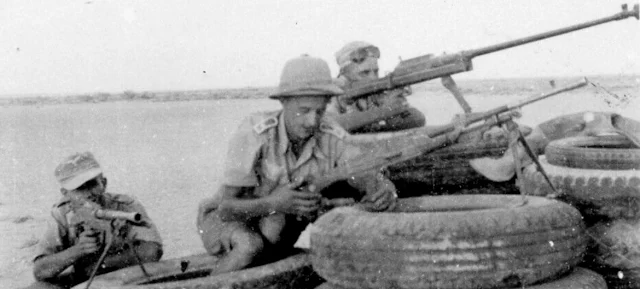









.jpg)


















